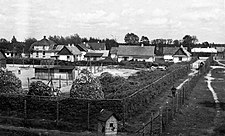
Back معسكر الإبادة سوبيبور Arabic Sobibor ölüm düşərgəsi Azerbaijani Собибор (үлем лагеры) Bashkir Собибор (лагер на смъртта) Bulgarian Sobibor Breton Sobibor Catalan Vyhlazovací tábor Sobibor Czech Sobibór udryddelseslejr Danish Vernichtungslager Sobibor German Στρατόπεδο εξόντωσης Σομπίμπουρ Greek
| Sobibor | |
|---|---|
| Extermination camp | |
 Sobibor extermination camp, summer 1943 | |
| Coordinates | 51°26′50″N 23°35′37″E / 51.44722°N 23.59361°E |
| Other names | SS-Sonderkommando Sobibor |
| Known for | Genocide during the Holocaust |
| Location | Near Sobibór, General Government (occupied Poland) |
| Built by |
|
| Commandant |
|
| Operational | May 1942 – 14 October 1943[1] |
| Inmates | Jews, mainly from Poland |
| Number of inmates | 600–650 slave labour at any given time |
| Killed | 170,000–250,000 |
| Notable inmates | List of survivors of Sobibor |
Sobibor (/ˈsoʊbɪbɔːr/ SOH-bi-bor; Polish: Sobibór [sɔˈbibur]) was an extermination camp built and operated by Nazi Germany as part of Operation Reinhard. It was located in the forest near the village of Żłobek Duży in the General Government region of German-occupied Poland.
As an extermination camp rather than a concentration camp, Sobibor existed for the sole purpose of murdering Jews. The vast majority of prisoners were gassed within hours of arrival. Those not killed immediately were forced to assist in the operation of the camp, and few survived more than a few months. In total, some 170,000 to 250,000 people were murdered at Sobibor, making it the fourth-deadliest Nazi camp after Auschwitz, Treblinka, and Belzec.
The camp ceased operation after a prisoner revolt which took place on 14 October 1943. The plan for the revolt involved two phases. In the first phase, teams of prisoners were to discreetly assassinate each of the SS officers. In the second phase, all 600 prisoners would assemble for evening roll call and walk to freedom out the front gate. However, the plan was disrupted after only eleven SS men had been killed. The prisoners had to escape by climbing over barbed wire fences and running through a mine field under heavy machine gun fire. About 300 prisoners made it out of the camp, of whom roughly 60 survived the war.
After the revolt, the Nazis demolished most of the camp in order to hide their crimes from the advancing Red Army. In the first decades after World War II, the site was neglected and the camp had little presence in either popular or scholarly accounts of the Holocaust. It became better known after it was portrayed in the TV miniseries Holocaust (1978) and the film Escape from Sobibor (1987). The Sobibor Museum now stands at the site, which continues to be investigated by archaeologists. Photographs of the camp in operation were published in 2020 as part of the Sobibor perpetrator album.

